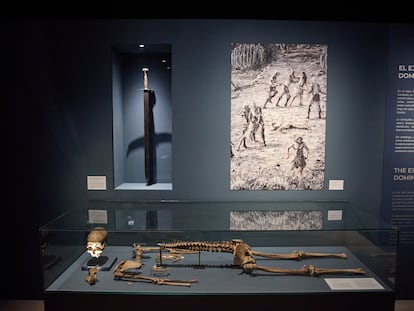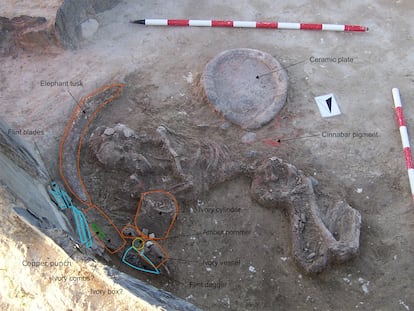A tomb for two kings and an ossuary for the bones of 3,000 people
The Church of St. Mary at Wamba, in the province of Valladolid, Spain, has a spectacular cemetery with thousands of human remains dating from between the 9th and 17th centuries

It was 1950 when Gregorio Marañón, a professor of Endocrinology at the Madrid School of Medicine, showed up with two trucks in the small town of Wamba, in the Spanish province of Valladolid. He entered the ossuary of the Church of St. Mary and filled the vehicles with human bones, which his students would practice on. While the reports have never been made public, it’s estimated that he removed the remains of some 6,000 people. However, he left in place the bones of another 3,000, which, today, make up a Catholic cemetery of significant proportions. But who do these bones belong to?
Nobody has a precise answer to this question, although scholars believe that they belonged to monks — as the temple had an adjoining monastery of the order of St. John of Jerusalem — soldiers, residents from the area, or religious pilgrims. They were mostly buried between the 9th and 17th centuries but three Visigothic sarcophagi (without lids) at the site may be even older. Experts believe that one may have housed the body of King Reccared I, who ruled Hispania from 586 AD until 601 AD. These coffins were discovered in a part of the convent that was completely dismantled after it was looted in the 19th century.
A recent study by Lorena Ortiz-Marín and Alicia Portela Estévez, from the Department of Biodiversity, Ecology and Evolution at the Complutense University of Madrid, is one of the reports that has been carried out on the church’s ossuary. Using 132 tibias from the parish cemetery (107 male and 25 female) to conduct their analysis, the experts conclude that a good part of the deceased suffered from osteoarthritis. This was likely caused by the harsh working conditions in the area, as for centuries the local economy depended on agriculture and livestock. However, despite the evident agrarian origin, the historical account of this town and its church is inextricably linked to the monarchy.
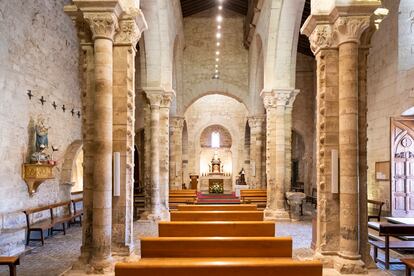
The history of the town of Wamba begins with the founding of the Church of St. Mary (Santa María) in the 7th century. Yet from the beginning of the Muslim conquest in 711 AD until the 10th century, there’s hardly any information: between the 8th and 9th centuries, the town was abandoned. But around the year 928 AD, Fruminius, the bishop of León, rebuilt the church on the remains of an old Visigothic site (the current one is Romanesque in style), while he built a new monastery, which was ceded to the monks of the Order of St. John of Jerusalem (later of Malta).
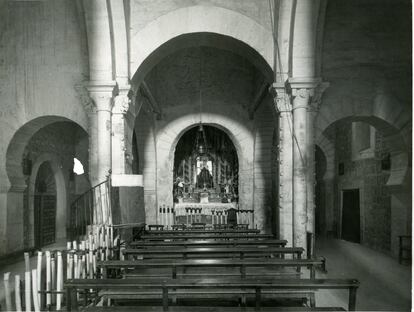
Maite Alonso, a tourism official for the church, recalls that the bones (which are now perfectly placed in the ossuary) were extracted from the surroundings of the temple, its interior and the monastery. “We don’t know what this [looked like] in the Middle Ages, since it has undergone many modifications. But yes, the concept of a cemetery, as we understand it, is French, from the 19th century. During the Middle Ages, people weren’t buried in cemeteries, but around churches or monasteries,” she explains.

In the history of this small municipality of around 300 inhabitants, at least four kings have come together. The first was King Reccared I, who owned a hunting estate in the Torozos mountains. He died in the town and was buried in the church. The second was Wamba, his successor, an elderly man forced by the nobility to accept the vacant throne. He did so on September 1, 672 AD. In the 12th century, Alfonso X of Castile (also known as “Alfonso the Wise”), who considered himself to be the heir of the Visigoths, transferred Reccared’s remains. He would do the same with those of Wamba, who was buried in 688, in Burgos. And the fourth king was — in reality — the queen consort of León, Doña Urraca of Portugal (1148-1211), who was buried in the monastery adjacent to Church of St. Mary at Wamba. Her body was not preserved.
In Wamba, everything revolves around the fascinating church and its square. The mixture of architectural styles — from the Romanesque to the 18th century, passing through the Mozarabic and the Cistercian — gives the well-preserved settlement the designation of Asset of Cultural Interest, a category of historical register in Spain. This is despite the consequences of multiple lootings, which almost completely destroyed the convent. Today, it is in private hands, and a shadow of its former self. In fact, not a single piece of its original colonnade remains, except for the stones on which the arches of the monastery were supported, as well as some cells where the monks slept. And, of course, the ossuary. It’s assumed that, at some point in the 20th century, large portions of the interior were transferred to the United States. “But the truth is that we don’t know where [the colonnade is],” admits Juan Pablo Hervada, the parish priest of Wamba.
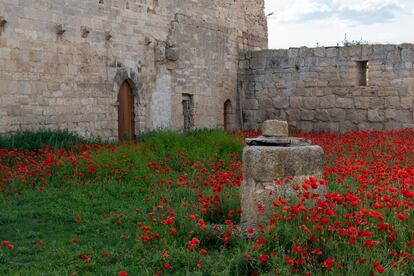
The floor plan of the temple is rectangular (60 feet long and 40 feet wide) and divided into nine areas, which are delimited by horseshoe arches and three apses. According to experts, the expansion of the temple and the opening of a square in front of it between the 19th and 20th centuries meant that the tombs had to be emptied, after excavations had taken place around them for centuries.
“At the end of the 1950s, as a consequence of the Second Vatican Council, an iconoclastic current ran through the Spanish temples. Numerous old carvings and altarpieces were removed from the churches and replaced by others. That was exactly what happened with the 18th-century altarpiece and with the small 17th-century carving of [St. Mary], which presided over the altar. The local women said: ‘That’s fine, if they don’t want the saints, they can leave [the church]... but they don’t leave town.’ For this reason, [the altarpiece] was kept in a chest in the parish house. Thanks to those brave women, the image is still with us today,” Hervada says.
When the current parish priest learned of its existence, he asked for its restoration and placed it on the altar, in the same place it had occupied until its removal. “It represents Santa María de la Esperanza, an invocation deeply rooted in the Hispano-Gothic cult, which makes experts think that it replaced a lost Romanesque one.”
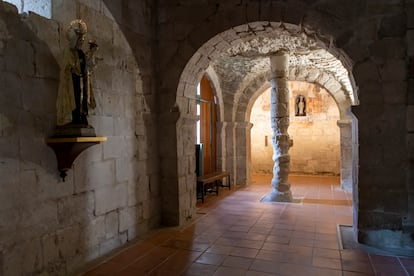
The replaced altarpiece also has a curious secret. Every September 8, when the Feast of the Nativity is celebrated, at around 6 p.m., the sun passes through the apse of the church and directly illuminates the face of the image. “Those who built the temple undoubtedly knew the movement of the stars and placed the carving in the exact place,” the parish priest explains.
Visiting the church is only possible on Saturdays, Sundays and holidays, from 11:00 a.m. to 1:30 p.m. and from 5:00 p.m. to 7:30 p.m. But it’s advisable to make a group reservation by calling ahead of time. “This [policy] is necessary,” Hervada insists, “to show respect for the church and the ossuary. It’s a Christian cemetery in a church, not a movie set. It’s been a place of worship for more than a thousand years.”
Sign up for our weekly newsletter to get more English-language news coverage from EL PAÍS USA Edition
Tu suscripción se está usando en otro dispositivo
¿Quieres añadir otro usuario a tu suscripción?
Si continúas leyendo en este dispositivo, no se podrá leer en el otro.
FlechaTu suscripción se está usando en otro dispositivo y solo puedes acceder a EL PAÍS desde un dispositivo a la vez.
Si quieres compartir tu cuenta, cambia tu suscripción a la modalidad Premium, así podrás añadir otro usuario. Cada uno accederá con su propia cuenta de email, lo que os permitirá personalizar vuestra experiencia en EL PAÍS.
¿Tienes una suscripción de empresa? Accede aquí para contratar más cuentas.
En el caso de no saber quién está usando tu cuenta, te recomendamos cambiar tu contraseña aquí.
Si decides continuar compartiendo tu cuenta, este mensaje se mostrará en tu dispositivo y en el de la otra persona que está usando tu cuenta de forma indefinida, afectando a tu experiencia de lectura. Puedes consultar aquí los términos y condiciones de la suscripción digital.
More information
Archived In
Últimas noticias
Welcome to the post-religion era: The idea of Christianity as the absolute truth has become obsolete
‘I thought you would like it’: The risky sexual practice popularized by TV shows and TikTok
The digitalization of tourism: ‘They promise experiences and gave us the worst possible one’
Mexican peso defies uncertainty with forecasts of a new period of stability in 2026
Most viewed
- Sinaloa Cartel war is taking its toll on Los Chapitos
- Reinhard Genzel, Nobel laureate in physics: ‘One-minute videos will never give you the truth’
- Oona Chaplin: ‘I told James Cameron that I was living in a treehouse and starting a permaculture project with a friend’
- Why the price of coffee has skyrocketed: from Brazilian plantations to specialty coffee houses
- Silver prices are going crazy: This is what’s fueling the rally

